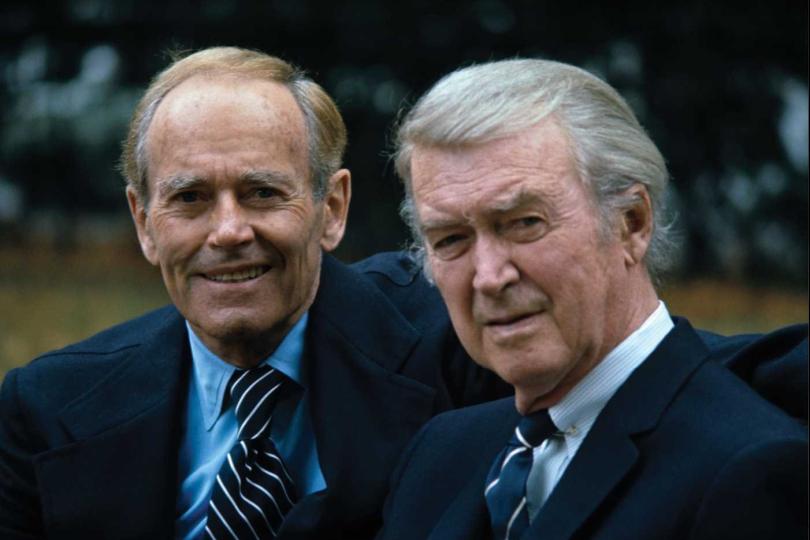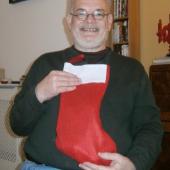Stewart and Fonda

In a way, they were like two sides of the same coin. One, a liberal Democrat and the other a conservative Republican, but as actors, they both embodied the American Everyman. Their work speaks for itself.
A genuine Midwesterner
Born in Nebraska, Henry Fonda (1905-1982) is one of the greats, from whose performances, actors can learn. Fonda, headed of an acting dynasty that includes his son Peter, daughter Jane, grandson Troy Garrity and granddaughter Bridget Fonda.
As a young man, Fonda was active in the Boy Scouts, but His father was a newspaper man. When young Henry observed a lynching during the 1919 Omaha race riots, he planned on being a writer, even attending the University of Minnesota as a journalism student. (He didn’t graduate).
Following work in community and stock productions, he worked with the University Players in Massachusetts. It was here that he met his future wife, the actress Margaret Sullavan. The marriage was short-lived but led to his lifelong friendship with James Stewart. He repeated his stage performance in The Farmer Takes a Wife, and at 20thCentury-Fox, starred opposite Janet Gaynor (the first Oscar-winning actress) to great success. In 1936, he starred with Sylvia Sidney and Fred MacMurray in the first technicolor outdoor production, The Trail of the Lonesome Pine. A year later, he again played opposite Sylvia Sidney, in Fritz Lang’s You Only Live Once. It is this film which later became the prototype for Arthur Penn’s Bonnie and Clyde. (In this writer’s opinion, the latter film doesn’t hold up because what was stylish at the time has faded with time.You Only Live Once offers a better interpretation of both story and characters).
The Grapes of Wrath
Fonda followed this with Jezebel costarring opposite Bette Davis, her second Oscar-winning role, but two years later, would play one of the greatest roles of his career: Tom Joad in The Grapes of Wrath. Adapted from John Steinbeck’s novel about an Oklahoma family moving to California during the Dust Bowl, this masterful film was directed by John Ford and follows the novel fairly well but eliminates and rearranges incidents in the story along the way. Still, with a cast that along with Fonda includes Jane Darwell (in an Oscar-winning performance), John Carradine, Charlie Grapewin (The Wizard of Oz) and Ward Bond, The Grapes of Wrath is one of the greatest, most important films of the 1940s.
This is not to say that Fonda abandoned the stage. While he continued to work in theater, it was in the 1940s that he appeared in Jesse James, Drums Along the Mohawk, Young Mr. Lincoln, The Lady Eveand The Ox Bow Incident.
A Little Show Called World War II...
Many able-bodied people from show business served in World War II, if not in the Armed Forces, in other ways such the Stage Door and Hollywood Canteens. Fonda, joined the Navy, serving as Quartermaster Third Class on the USS Satterlee. He later became a commissioned Lieutenant and was awarded both a Navy Presidential Citation and a Bronze Star. Returning home, he played opposite Linda Darnell and Victor Mature in John Ford’s My Darling Clementine. These were followed by Daisy Kenyon, and Fort Apache, the latter with John Wayne and an adult Shirley Temple.
...and Mister Roberts
Based on a novel by Tom Heggen, Fonda was given one of his signature characters in Mister Roberts. The play follows the experiences of Lt. Douglas Roberts, a junior officer, not letting the condition of the world affect him while battling a domineering captain. Winning his first Tony for the role, he followed this with another military story, The Caine Mutiny Court-Martial. While he was unhappy with his own role in it, Fonda, along with the playwright William Gibson helped launch Anne Bancroft toward stardom when they appeared on Broadway in Two for the Seesaw.
John Ford’s film version of Mister Roberts, with a cast that includes James Cagney, Jack Lemmon and William Powell, isn’t easy to find on DVD, but if you can, the film is superb. This is a play that’s ripe for revival!
Among his films of the 1950s are War and Peace, Hitchcock’s The Wrong Mannand the renowned, oft-revived drama, 12 Angry Men, written by Reginald Rose and directed by Sidney Lumet. Along with an exceptional cast, the drama of twelve men determining the fate of a young man accused of murder, was critically acclaimed and remains a noir classic. Fail-Safe was a biting drama on the Cold War, and Spencer’s Mountain is a memoir which later became the TV series, The Waltons.
Fonda’s personal life was filled with contradictions and tragedy. His first wife, Margaret Sullavan would later marry Fonda’s friend, producer Leland Palmer. She would later commit suicide while married to Palmer. His second wife, Frances Ford Seymour Brokaw, came from a wealthy family. Fonda met her while making a film in the UK. They had two children, Jane, born in 1937 and Peter, born three years later. Sadly, their marriage wasn’t a happy one. Following their divorce, Frances was institutionalized, and she, too, succumbed to suicide. Evidently, Jane Fonda didn’t know how her mother had passed on until she read about it in a magazine.
Fonda’s third wife, Susan Blanchard, was the young stepdaughter of Oscar Hammerstein II and his second wife, Dorothy. Susan and Fonda were married for three years and adopted a daughter, Amy. A few years later, he took Italian baroness Afdera Franchetti as his fourth wife. Following their divorce, he married Shirlee Adams and they were the last 17 years of his life. As he aged, Fonda worked with his many friends, including James Stewart, Kirk Douglas, E. G. Marshall, Richard Widmark, Olivia de Havilland, Jose Ferrer, Shelley Winters and Ava Gardner.
Clarence Darrow
The solo play came into prominence in the mid-1970s and Henry Fonda led the way with his outstanding, Tony Award-winning performance as Clarence Darrow. Adapted by David Rintels from Irving Stone’s biographical novel, the play follows Darrow as he discusses his life and career, including both the Scopes Monkey Trial and the Leopold and Loeb murder case. Fonda toured in the play and later filmed it for PBS.
At the age of 70, Fonda was given a pacemaker following prostate cancer. Fonda continued working onstage in such plays as First Monday in October (costarring Jane Alexander), Our Town and The Time of Your Life.
It was Jane Fonda’s wish that her father and brother would appear in a film together. While Peter Fonda opted out, Henry Fonda’s last film is Mark Rydell’s beautiful screen adaptation of Ernest Thompson’s play, On Golden Pond. Costarring the magnificent Katharine Hepburn, the project was one of those works everyone wishes they could be a part of, even if it was only doing the ensemble’s laundry. Hepburn even gave Fonda one of Spencer Tracy’s hats, which he wore in the film. The story of Norman and Ethel Thayer, in what will be their last summer at their cottage on Golden Pond, is deeply emotional. Norman is showing signs of Alzheimer’s and their daughter, Chelsea, has arrived to ask them to care for Billy, her fiancé’s son, while they go to Europe. A sensitive family drama, Norman and Billy share a love for fishing and bond over the summer.
Henry Fonda and Katharine Hepburn both won Oscars for their performances. It was his first and Hepburn’s fourth. Jane Fonda accepted the Oscar for her father because he was too ill to attend. This film brought Henry and Jane Fonda closer, but his relationships with his children was distant at best. Jane’s left-wing activism strained Fonda’s friendships with Republican actors John Wayne and James Stewart. However, when he passed away from heart disease, his family, including Jane and Peter Fonda, were with him. In his honor, he received a stamp in 2005, and the Fonda Theater in Hollywood was named in his honor.
Indiana, Pennsylvania
The curiously named location of Indiana, Pennsylvania is the birthplace of another great Everyman actor, James Stewart (1908-1997). Known for his “Aw, shucks” approach to roles and no-nonsense acting, Stewart also served in the military during World War II and the Vietnam War, obtaining the rank of Brigadier General in the Air Force Reserve.
As a child, however, Stewart’s father refused him piano lessons, but agreed to accordion lessons later. His ability with the instrument helped Stewart to relax offstage. Athletic, Stewart played football and track, and at one time, worked as a magician’s assistant. Obsessed with model airplanes, he would later fulfill the dream of playing Charles Lindbergh in The Spirit of St. Louis.
While at Princeton, Stewart’s artistic interests led him to the University Players on Cape Cod, where he and Henry Fonda would share a flat with Joshua Logan and Myron McCormick. This led to his Broadway debut. Following the failure of Carry Nation, he stole the show when he played a small role in a minor hit, Goodbye Again. He continued to work but not in anything successful. When an MGM talent scout offered him a seven year contract, Stewart accepted.
Hooray for Hollywood
That contract allowed him to appear in mediocre films, the best of which was Wife Vs. Secretary, starring Jean Harlow.
When he was cast opposite his friend Margaret Sullavan in Next Time We Love, his natural abilities worked well for him. Sullavan’s husband, Leland Palmer would become his agent as well. After a brief affair with Norma Shearer led to several collaborations with director Frank Capra. He was first cast in the film adaptation of You Can’t Take It with You, costarring Jean Arthur. The film was named Best Picture of 1938 and resembles the play in title and characters, the story going in a different direction.
The following year, Capra, Stewart and Arthur worked on Mr. Smith Goes to Washington, a film Stewart always counted among his best. As an ambitious, idealistic young man clashing with the U.S. Senate as a senior Senator attempts to discredit Smith’s pet project until he stands up for himself, passionately addressing the Senate from the floor. A smash hit, this film moved Stewart to the top ranks of American actors.
He followed this with the delightful western, Destry Rides Again, costarring Marlene Dietrich, whose rendition of “See What the Boys in the Back Room Will Have,” is one of her greatest hits. Paired with Sullavan again in 1940, the lovely romantic comedy The Shop Around the Corner may be more familiar today as the musical, She Loves Me, but cleverly and stylishly directed by Ernst Lubitsch, the film’s a gem. That same year, Stewart was paired with Cary Grant and Katharine Hepburn for The Philadelphia Story, George Cukor’s film of the Philip Barry comedy which earned Stewart his Oscar. (He felt that it was compensation for not receiving the award for Mr. Smith Goes to Washington). Two seldom-seen comedies followed: No Time for Comedy, costarring Rosalind Russell and Pot o’ Goldwith Paulette Goddard.
Military Career
Stewart earned his pilot’s license in 1938 and was drafted in 1940. Stewart became part of the U.S. Army Air Force, the first major celebrity to wear a uniform. He helped train pilots and became a commissioned officer in 1942. Stewart, like many others, made public appearances and performed on radio, but by the time the War was over, Stewart had risen through the ranks and was much-honored for his services.
He returned to work with Frank Capra’s It’s a Wonderful Life, a failure upon its release, but now a beloved film classic. He followed this with Rope, Alfred Hitchcock’s drama version of the aforementioned Leopold and Loeb case.
Harvey
When Frank Fay’s contract ended, Stewart replaced him in what would become another signature role, that of Elwood P. Dowd in Mary Chase’s Pulitzer Prize-winning comedy, Harvey. Stewart continued in the play for three years and followed with the film version. He returned to the role 25 years later, both on Broadway and in London. He also played it on television and this version can be found on YouTube.
During the 1950s, Stewart’s costars included Spencer Tracy, June Allyson and Jeff Chandler, but his more memorable performances are in Cecil B. DeMille’s The Greatest Show on Earth, as Buttons the Clown, a character who hides behind his makeup to cover up his past, and as Charles Lindbergh in The Spirit of St. Louis.
As the Studio System started to crumble, Stewart continued working in such films as Winchester ’73, The Glenn Miller Strategic Air Command, but his next wave he starred for Hitchcock in Rear Window( costarring Grace Kelly), The Man Who Knew Too Much (with Doris Day) and the masterpiece, Vertigo (opposite Kim Novak). In this latter, he plays a retired detective with acrophobia who becomes the unwitting accomplice in a murder when he becomes obsessed with the victim. A few years later, Stewart and Novak would reteam for Bell, Book and Candle.
Anatomy of a Murder, The Man Who Shot Liberty Valance, How the West Was Won and Shenandoah were some of his films from the 1960s. On television, he played a college professor in The Jimmy Stewart Show and a small-town lawyer in Hawkins. He costarred with Bette Davis in the TV-film version of Right of Way, which, as a play, had premiered at the Guthrie Theater.
Stewart retired following the deaths of his good friends, Henry Fonda and Grace Kelly, but not before presenting an honorary Oscar to Cary Grant. His wife, Gloria Hatrick McLean passed away in 1994 and four years later, at the age of 89, Stewart suffered from cardiac arrest.
Henry Fonda and James Stewart are two of the finest actors ever to appear onstage or screen and their work speaks for itself.




